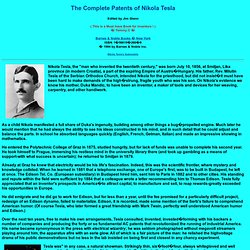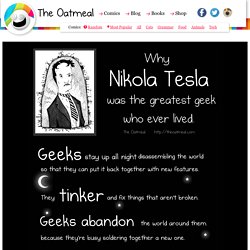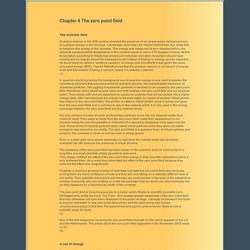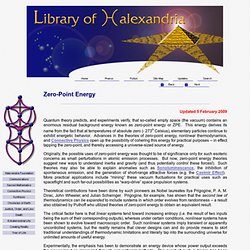

Secret of Nikola Tesla (full length) HOW OUR FUTURE WOULD HAVE BEEN WITH TESLA TECH/BY NIKO TESLA. Nikola Tesla - The Complete Patents of Nikola Tesla - The Man who invented the 20th Century. The Complete Patents of Nikola Tesla Edited by Jim Glenn ( This is a Must Have Book for Inventors !

) Tommy C Barnes & Noble Books New York ISBN 1566192668 1994 by Barnes & Noble Inc. Nikola Tesla's Automobile Nikola Tesla, the "man who invented the twentieth century," was born July 10, 1856, at Smiljan, Lika province (in modern Croatia), a part of the expiring Empire of AustroHungary. As a child Nikola manifested a full share of Duka's ingenuity, building among other things a bugpropelled engine. He entered the Polytechnic College of Graz in 1875, studied hungrily, but for lack of funds was unable to complete his second year. Already at Graz he knew that electricity would be his life's fascination. He did emigrate and he did go to work for Edison, but for less than a year, until the fee promised for a particularly difficult project, redesign of an Edison dynamo, failed to materialize.
Tesla was" in any case, a natural showman. A 1902 venture, with J. Marconi v. Tesla's Biography. Nikola Tesla. Nikola Tesla (Serbian Cyrillic: Никола Тесла; 10 July 1856 – 7 January 1943) was a Serbian-American[3][4] inventor, electrical engineer, mechanical engineer, physicist, and futurist who is best known for his contributions to the design of the modern alternating current (AC) electricity supply system.[5] Born and raised in the Austrian Empire, Tesla received an advanced education in engineering and physics in the 1870s and gained practical experience in the early 1880s working in telephony and at Continental Edison in the new electric power industry.

He emigrated to the United States in 1884, where he would become a naturalized citizen. He worked for a short time at the Edison Machine Works in New York City before he struck out on his own. With the help of partners to finance and market his ideas, Tesla set up laboratories and companies in New York to develop a range of electrical and mechanical devices. Early years Tesla's baptismal record, 28 June 1856. Why Nikola Tesla was the greatest geek who ever lived. Additional notes from the author: If you want to learn more about Tesla, I highly recommend reading Tesla: Man Out of Time Also, this Badass of the week by Ben Thompson is what originally inspired me to write a comic about Tesla.

Ben's also got a book out which is packed full of awesome. There's an old movie from the 80s on Netflix Instant Queue right now about Tesla: The Secret of Nikola Tesla. It's corny and full of bad acting, but it paints a fairly accurate depiction of his life. The drunk history of Tesla is quite awesome, too. History.com has a great article about Edison and how his douchebaggery had a chokehold on American cinema. Zero Point Energy. The zero point field. Chapter 4 The zero point field The invisible field Quantum science in the 20th century revealed the presence of an all-pervasive background sea of quantum energy in the universe.

Cambridge University’s Dr. Harold Puthoff was one of the first to measure this energy of the universe. This energy was measured at zero degrees Kelvin, the absolute lowest possible temperature in the universe equal to minus 273 degrees Celsius. In quantum electrodynamics the background sea of quantum energy is now used to explain the uncertainty principle that was discovered by quantum physics, the unpredictable behaviour of subatomic particles.
Not only photons but also all sorts of elementary particles come into our physical reality from nowhere at all. Even in a pitch-dark room where absolutely no light from the outside world can penetrate, scientists can still measure the presence of virtual photons. Zero-point energy. Zero-point energy, also called quantum vacuum zero-point energy, is the lowest possible energy that a quantum mechanical physical system may have; it is the energy of its ground state.

All quantum mechanical systems undergo fluctuations even in their ground state and have an associated zero-point energy, a consequence of their wave-like nature. The uncertainty principle requires every physical system to have a zero-point energy greater than the minimum of its classical potential well. This results in motion even at absolute zero. For example, liquid helium does not freeze under atmospheric pressure at any temperature because of its zero-point energy. History[edit] In 1900, Max Planck derived the formula for the energy of a single energy radiator, e.g., a vibrating atomic unit:[5] where is Planck's constant, is the frequency, k is Boltzmann's constant, and T is the absolute temperature. According to this expression, an atomic system at absolute zero retains an energy of ½hν.
Varieties[edit] . Zero-Point Energy. Updated 5 February 2009 Quantum theory predicts, and experiments verify, that so-called empty space (the vacuum) contains an enormous residual background energy known as zero-point energy or ZPE.

This energy derives its name from the fact that at temperatures of absolute zero (- 273o Celsius), elementary particles continue to exhibit energetic behavior.